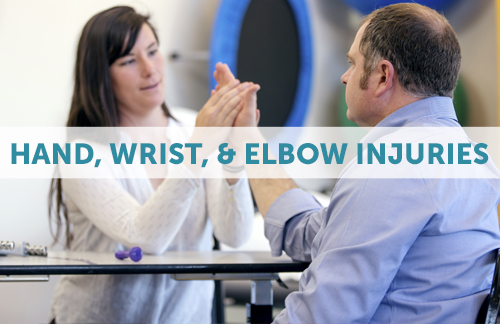Certified Hand Therapy (CHT)
As human beings, we value the use of our hands and arms to perform all of the occupations that encompass our lives. Whether it is driving to work or getting dressed, the loss of upper extremity use during these activities as a result of an injury or surgery can be debilitating. A certified hand therapist has the highest level of training in the profession for treating the hand, wrist, elbow, and shoulder. They are required to have at least 3 years of experience including 4000 hours of direct practice in hand therapy. They must also pass a comprehensive exam testing the advanced knowledge of skill and theory required to treat the upper limb.
Common Injuries Treated by Certified Hand Therapists*
*Not all services available at all CHT locations
- Arthritis (OA and RA)
- Complex regional pain syndrome/RSD
- Cumulative trauma disorders (i.e. carpal tunnel syndrome)
- Dupuytren’s contracture (post-surgery)
- Fractures and crush injuries
- Ligament injuries, strains, sprains
- Post CVA rehabilitation of upper extremity
- Shoulder injuries ( i.e. Rotator cuff tear/ repair, thoracic outlet, labral tears/repairs)
- Sports Injuries of the upper extremity
- Tendinitis (i.e. shoulder impingement, trigger finger, DeQuervains, epicondylitis)
- Tendon and nerve repairs
- Wound and burn management
Common Certified Hand Therapy Services

Custom Splints & Orthotics
Expand For More Info
A custom splint is made specifically to fit your body and is typically used to help stabilize joints, and reduce pain and swelling. Custom splints often help the body heal more effectively than an off-the-shelf brace. A certified hand therapist will regularly adjust the splint as your body heals.

Hand, Wrist, & Elbow Injuries
Expand For More Info
Injuries to the hand can often be complex and include damage to nerves, tendons, bones, joint capsule structures, and vascular tissues. There are many hand conditions that can require certified hand therapy. Some of the most common are fractures, tennis elbow, and nerve compressions.
Common Upper Extremity Injuries
Carpal Tunnel Syndrome: The carpal tunnel is a small space at the wrist in which the median nerve and nine tendons pass through. The tunnel itself is made up of your wrist bones and along the top of the tunnel is a thick fibrous ligament called the transverse carpal ligament. If the tendons become swollen (tenosynovitis) or if the tunnel size itself decreases because of injury, compression to the median nerve can occur.
Rheumatoid Arthritis & Osteoarthritis There are several types of arthritis, which can be defined as inflammation, degeneration, or infection of a joint. Some types of arthritis just affect a few joints and are called oligoarthritis. Others affect many joints in the body and are called polyarthritis. Arthritis can be symmetric, meaning the pain and inflammation is roughly the same on both sides of the body. It can also be asymmetric, affecting just about any joint in the body at any given point in time.
Tennis elbow, also known as lateral epicondylitis is an inflammation of the tendon fibers that attach the forearm extensor muscles to the outside of the elbow. More recently it is believed that tennis elbow is due to the degeneration of the wrist extensor tendons. Pain may be felt where these fibers attach to the bone on the outside of the elbow or along the muscles in the forearm.
Trigger Finger also known as stenosing tenosynovitis, occurs when inflammation narrows the space in the sheath that surrounds the tendon in the finger. This means that the finger doesn’t move smoothly anymore – in fact, it often “snaps” from a bent position to a straight position, similar to a trigger being pulled and released. If the swelling is severe enough, it could cause a finger to remain in a bent position.

Shoulder Injuries
Expand For More Info
The shoulder joint is capable of a wider and more varied range of motion than any other joint in the human body. Unfortunately, because the shoulder is so flexible, it also tends to be unstable. And this instability contributes to a variety of problems, some of which can be treated with rest and others that may require the expertise of a licensed therapist.
There are several factors involved in shoulder disorders:
- Aging Process – including disuse and atrophy
- Strain and Overuse
- Trauma
- Poor posture
It is not uncommon for many shoulder problems to result from a combination of these factors.
Common Shoulder Injuries
Rotator Cuff Injuries: Tears in the rotator cuff can result from the progressive worsening of tendonitis, repetitive strain through overuse, or trauma–especially as a result of athletics. The gradual tearing of the rotator cuff is a process similar to a shirt wearing out–it gets more and more threadbare until the edges fray or a hole appears. This sort of rotator cuff injury can be difficult to repair surgically, and conservative treatment under the direction of a therapist is often the best treatment.
Osteoarthritis is a condition in which the joint cartilage deteriorates and the joint becomes gritty and rough. It can be caused by a number of factors, including disease, trauma, and infection.
Besides being painful arthritis can lead to “frozen shoulder,” which is the inability to fully move the arm due to tightness in the joint; attempts at movement in the later stages of the condition are usually painful. In advanced cases, arthroplasty (replacing the joint) is an option that relieves pain and improves mobility.
A dislocation is far more serious, involving tissue damage, stretching, and tearing. Unlike a subluxation, the shoulder does not “pop back in”. People under 20 and over 50 are more prone to dislocations.
Impingement refers to a condition in which there is decreased space in the suprahumeral joint for the rotator cuff tendons, long head of the bicep and bursa to glide without increased pressure and pain.


